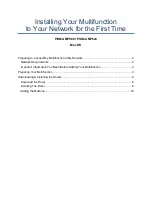
Environment
2-4
Generic MICR Fundamentals Guide
MICR printing technologies
The following basic printing techniques are capable of
generating magnetic characters:
•
Letterpress
Letterpress is based upon a raised typeface that sits above
the plane of the image carrier. The typeface is inked with
special magnetic ink and applied to the paper under
pressure. Common forms of letterpress are: hot metal type,
sequential number machines, and ribbon encoders.
•
Offset lithography
Large offset devices are typically used to produce check
stationery. The lithographic process uses magnetic ink and
water to shape the image on a plate. The image is transferred
to a rubber sheet called a blanket. The image is then “offset”
to the paper.
•
Impact ribbon encoding
Ribbon encoding, also called “direct printing,” is a letterpress
technology with a different delivery method. Instead of the ink
being applied to the typeface and then to the paper, the ink is
suspended on a thin sheet of backing (usually a polymer
base) called a ribbon.
The ribbon is held between the typeface medium (drum,
daisy wheel, or hammer) and the paper, so that when the
typeface is struck against the paper, the components on the
ribbon are trapped and pressed onto the document to be
printed.
•
Non-impact (xerography and ionography)
Non-impact printing technologies have been growing in
market penetration. They require highly sophisticated and
consistent equipment utilizing magnetic materials.
•
Thermal ribbon encoding
A non-impact, thermal transfer version of ribbon encoding
combines some of the characteristics of the conventional
ribbon encoding with those of non-impact technology.
Summary of Contents for 6100BD - Phaser Color Laser Printer
Page 1: ...January 2003 701P22140 Xerox Document Services Platform Generic MICR fundamentals guide...
Page 17: ...Overview Generic MICR Fundamentals Guide 1 7 Figure 1 2 Life cycle of a check...
Page 22: ...Overview 1 12 Generic MICR Fundamentals Guide...
Page 46: ...Paper facts 3 18 Generic MICR Fundamentals Guide...
Page 74: ...Document design 4 28 Generic MICR Fundamentals Guide...
Page 86: ...Document processing 5 12 Generic MICR Fundamentals Guide...
Page 105: ...Quality control Generic MICR Fundamentals Guide 6 19 Figure 6 12 E13B characters and waveforms...
Page 146: ...Security 8 18 Generic MICR Fundamentals Guide...
Page 150: ...References A 4 Generic MICR Fundamentals Guide...
Page 164: ...Glossary Glossary 14 Generic MICR Fundamentals Guide...
















































